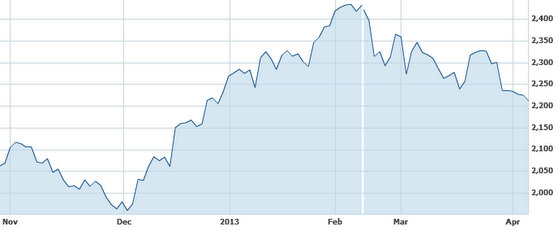ONE WORRIED market watcher says a possible recovery in A-shares could be derailed by any of these six factors.
First on the radar screen pointing to potential trouble ahead is China’s high-flying property sector, which is always teetering on the precipice given the attention it receives from economic regulators.
With their heavy market cap representation among Shanghai Composite constituent listcos, China’s real estate plays invariably must operate with one eye on the competition and another on policymakers in Beijing.
 China's all-important property sector could make or break any market rally. Photos: China New Town DevelopmentHowever, with recent inflation growth figures in China slightly lower than expectations, some of the policy overhang – or threat thereof – to the property sector has been minimized.
China's all-important property sector could make or break any market rally. Photos: China New Town DevelopmentHowever, with recent inflation growth figures in China slightly lower than expectations, some of the policy overhang – or threat thereof – to the property sector has been minimized.The Southern Chinese city of Guangzhou, one of the country’s most vibrant commercial metropolises, saw March property prices rise by their fastest rate in two years.
This prompted authorities to implement a new policy in late April which mandates that advance sales of lots and finished units must be published online with both volume and prices made public in order to help curb speculation and maintain price stability.
Guangzhou thus becomes the second PRC market after Beijing to put in place such anti-speculative price-control measures.
If this trend catches on and goes nationwide, then investors in listed property developers will surely get spooked and cash in their chips in large numbers, thus dragging down the broader stock market.
Secondly, China’s chief measure of industrial vitality – the Purchasing Managers’ Index (PMI) – is closely monitored each month as a barometer of the county’s factory activity.
A major reason for the losing stock market session on Thursday – the first trading day since the five-day market break to commemorate Labor Day – was the lower-than-expected April PMI number.
Market watchers had been guiding for a PMI of around 51.0 for the month, but it fell to 50.6 in April, down from the 11-month high of 50.9 set the month prior.
With China’s manufacturing sector still dangerously skewed toward overreliance on the West for export orders, the anemic economic recoveries in the EU and the US are putting more pressure on manufacturers.
And there are few signs that the ongoing campaign to boost domestic consumption in the face of stagnant external demand is gaining any measureable traction.
One bright spot is that the new national leadership in Beijing seems committed to maintaining economic stability in large part through a continuation of major infrastructure projects.
The third dark cloud on the horizon is the potential for a technical correction, especially related to the seasonal downtrend often afflicting markets this time of year called: “Sell in May and go away.”
With the benchmark Shanghai Composite at 2,174 at the closing bell on Thursday, it’s a hop and a step better than the long-term low of 1,949 seen in December last year.
 Recent China shares performance. Source: Yahoo Finance
Recent China shares performance. Source: Yahoo FinanceHowever, it’s still down 9.5% from year-earlier levels and over 10% weaker than the YTD high hit in February.
The fourth downside driver for China shares lately has been the bad news seen from both the brokerage and bond markets.
It was recently reported that leading executives from investing bodies including Citic Securities, Wanji Asset Management, Qilu Bank and Sealand Securities are all under investigation by the Ministry of Finance for various trading allegations.
Listed brokerages have been one of the bright spots of late in terms of share prices, and if their integrity is further drawn into question, that could be bad news for the broader bourse.
Furthermore, many analysts have been downplaying the potential negative market impact from both the most recent Sichuan earthquake and the appearance of a new strain of bird flu in China.
However, if they are wrong, then several sectors from hospitality to travel and retail could all be hit hard.
Finally, wildcards like the volatile situation on the Korean Peninsula and testy Sino-Japanese ties always have the potential to escalate and impact the region’s stock markets.
See also:
'China's Buffett' Going Green




